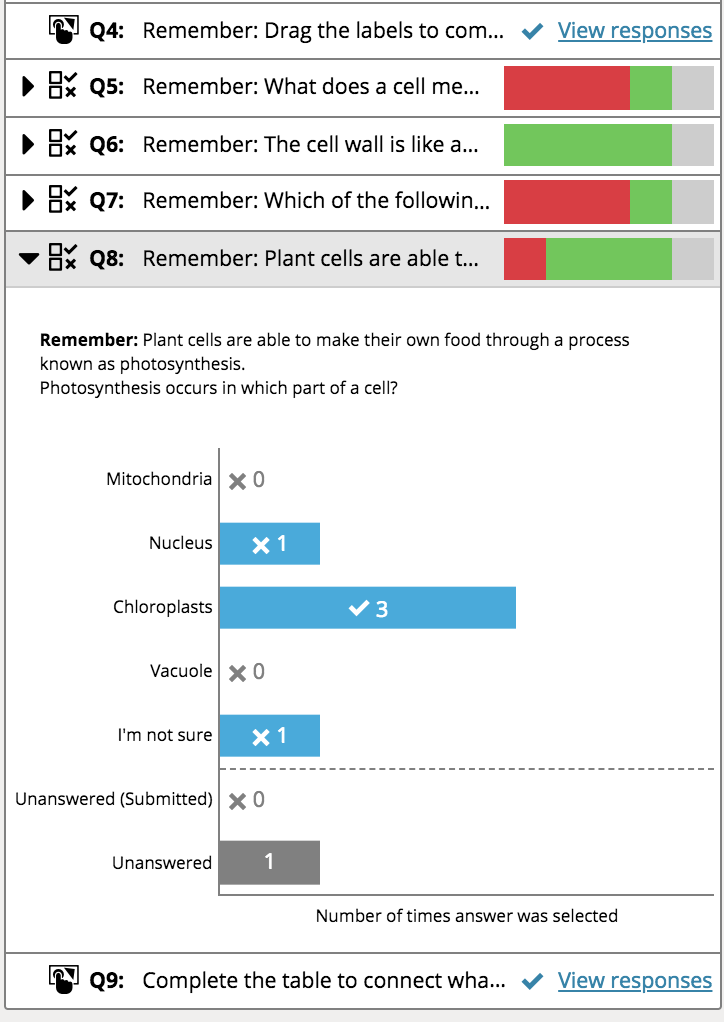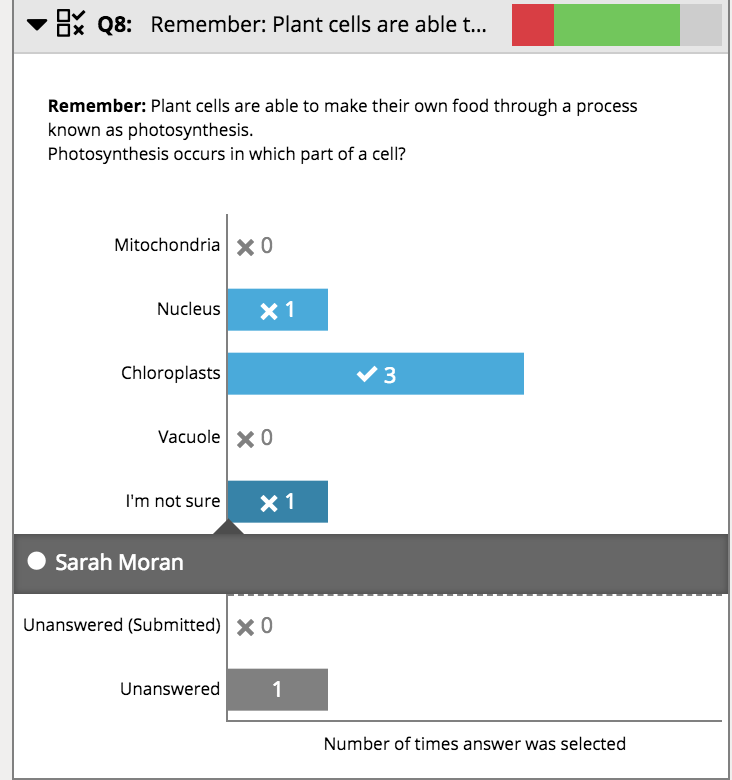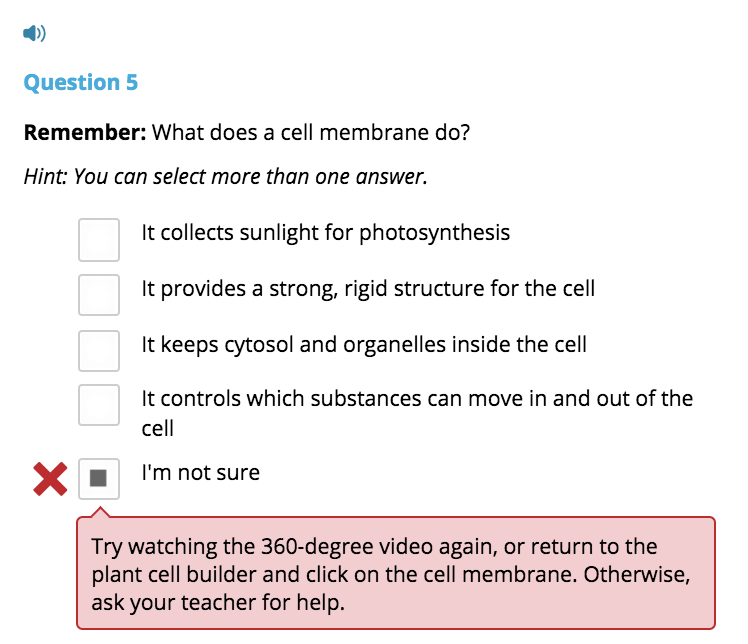Why we include an “I’m not sure” option in all multiple-choice questions

Stile lessons are built based on best-practice pedagogies and teaching and learning strategies. Every decision we make for the lessons and the platform itself is thoroughly researched and considered for the impact that it will have on teaching and learning.
One thing that we often get asked about is our decision to include an “I’m not sure” option for multiple choice questions.
We include an “I’m not sure” option for all multiple-choice questions in our non-assessed lessons, as we want to encourage a classroom culture where students can feel comfortable to express their uncertainty and to seek further help to find the correct answer.
As we view lessons as formative assessment opportunities, feedback forms an important part of this process to maximise student learning. Formative assessment helps students interpret feedback as a means of learning rather than as punishment or reward (Tunstall, 1996). Although we acknowledge the importance of performance, especially on standardized tests, student motivation for learning is more closely tied to formative assessment. Rather than performing to get a grade, the focus is on learning to understand. (Tunstall, 1996).
Traditional multiple choice questions tend to just look at correct responses. They do not measure student confidence and level of understanding. When you allow students to reflect on their confidence (such as providing an “I’m not sure” option) the benefits include:
- improved self‐monitoring (Graber, 2009)
- reinforcement of the notion that guessing should be discouraged (Burton, 2002)
- a pedagogical advantage over traditional multiple choice questions (Swartz, 2006; Curtis, Lind, Boscardin & Dellinges, 2013)
You are also provided with richer data to determine appropriate interventions. Student responses can be:
- informed where all the correct responses are selected
- partially informed where one correct answer is selected, but not all of them.
- misinformed where incorrect answers are selected
- uninformed — where students selected that they were not sure of the answer. They lack knowledge and are not confident of the answer.
While results from traditional MCQ assessments provide educators with details about what students know, they provide educators with less information about what they might do or what they are thinking. When you include confidence, you are able to differentiate from the uninformed to the misinformed (Curtis, Lind, Boscardin & Dellinges, 2013). Both of these responses will require different remediation strategies.
When a student selects the “I’m not sure” option, two things happen:
- As the teacher, you are provided with real-time insight into your students’ understanding of a question. The Class insights feature allows you to view this at a whole-class level, and by clicking on any incorrect or “I’m not sure” options, you will be able to immediately assist any students that are having difficulty:


2. Upon submission of their work, the student will be provided with feedback that will provide them with a cue or a strategy to help them find the correct answer. They can then take back their work and have another go (and teachers can see how many times students have taken back work at the top of their submission). This type of feedback helps students develop strategies to answer similar questions in the future, and is more effective than feedback about the question or task itself:

Without an “I’m not sure” option, students have a fair chance of ‘fluking’ the answer, which thereby provides an inaccurate representation of their understandings to both themselves, and you as the teacher.
It’s also important to note that we do not include an “I’m not sure” option in summative assessment tests. We understand that there is a need for students to develop ‘test-taking’ skills, and to develop effective strategies for answering multiple-choice questions such as eliminating implausible distractors, and taking their ‘best guess’. Summative assessment tasks and quizzes provide the most appropriate time to do this, hence why the “I’m not sure” option is removed.
We recommend sharing the reasoning for the inclusion and exclusion of “I’m not sure” options in Stile with your students. During a lesson, selecting “I’m not sure” provides them with opportunities to develop their understanding and learning strategies, and in a test, it helps them develop effective test and exam strategies.
What if my students keep selecting “I’m not sure” as an “easy way out”?
If you find that a student just always ticks “I’m not sure” without putting in any effort, you might also like to take the time to have a conversation with them to find out why they’re selecting this option, or get them to talk about what they do know in class (via Class insights) if you’re not able to take them aside after class. You can always request a resubmission to let them know that such behaviour isn’t up to par.
And remember, the beauty of Stile is that if you don’t agree with our pedagogical decision to include ‘I’m not sure’ options — you can always delete them!
References
Burton, RF 2002, ‘Misinformation, partial knowledge, and guessing in true/false tests’, Medical Education, vol. 36, no 9, pp. 805–811.
Curtis DA, Lind SL, Boscardin CK & Dellinges M, 2013, ‘Does student confidence on multiple-choice question assessments provide useful information?’, Medical Education, vol. 47, no 6, pp. 578–584.
Graber, ML 2009, ‘Educational strategies to reduce diagnostic error: can you teach this stuff?’, Advances in Health Sciences Education, vol. 14 (Suppl), pp. 63–69.
Swartz, SM 2006, ‘Acceptance and Accuracy of Multiple Choice, Confidence-Level, and Essay Question Formats for Graduate Students’, Journal of Education for Business, vol 81, no. 4, pp. 215–220.
Tunstall, P 1996, ‘Teacher Feedback to Young Children in Formative Assessment: a typology’, British Educational Research Journal, vol. 22, no. 4, pp. 389–404.

